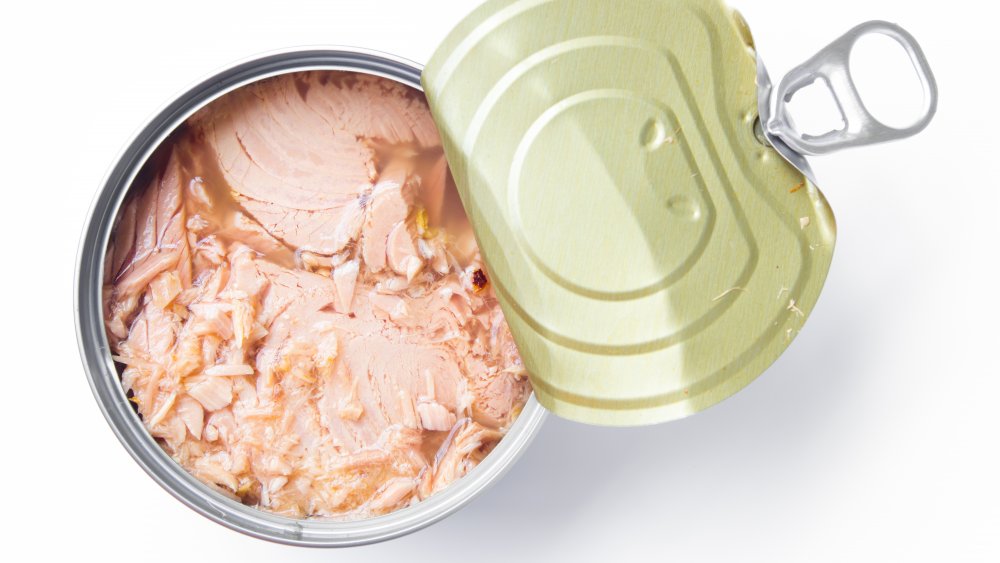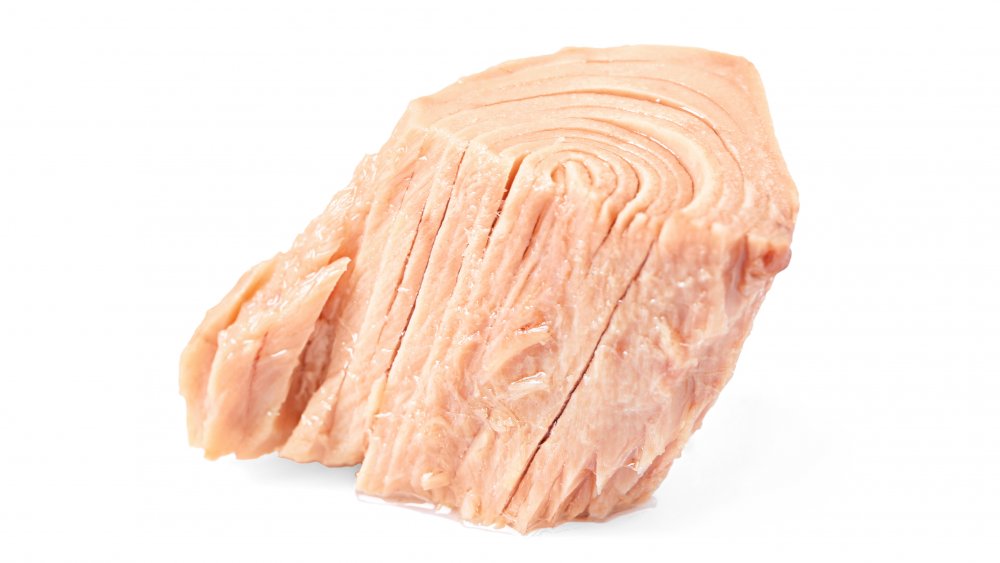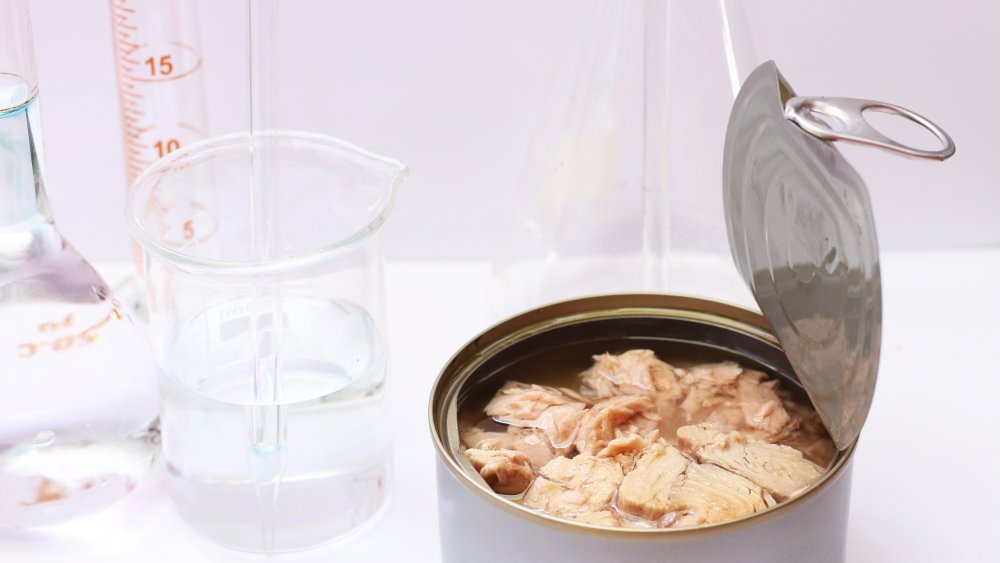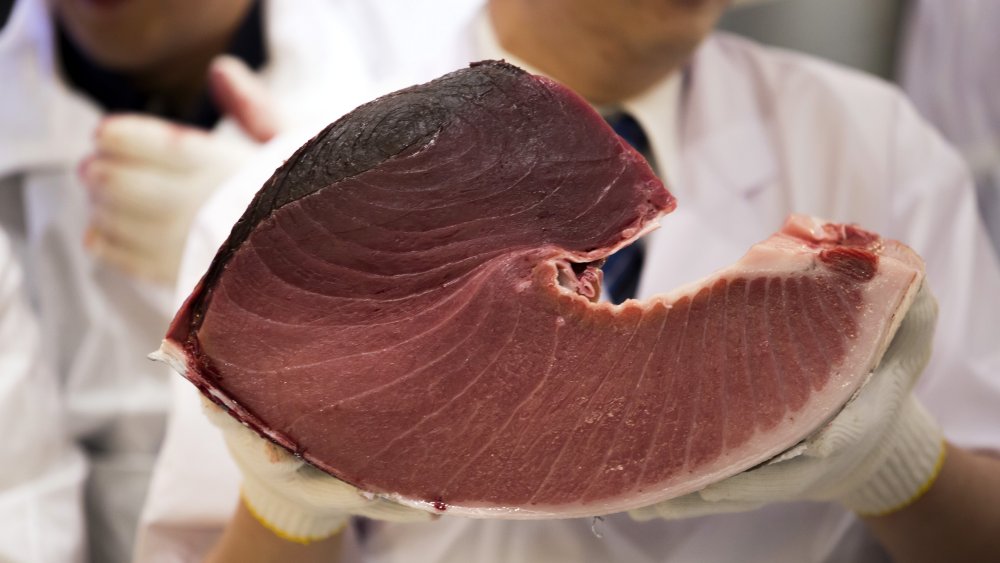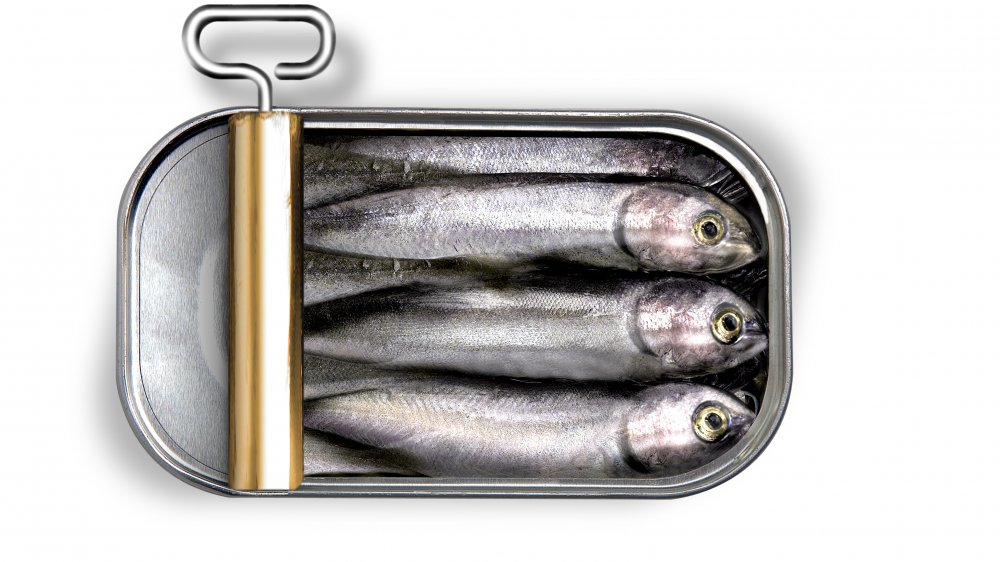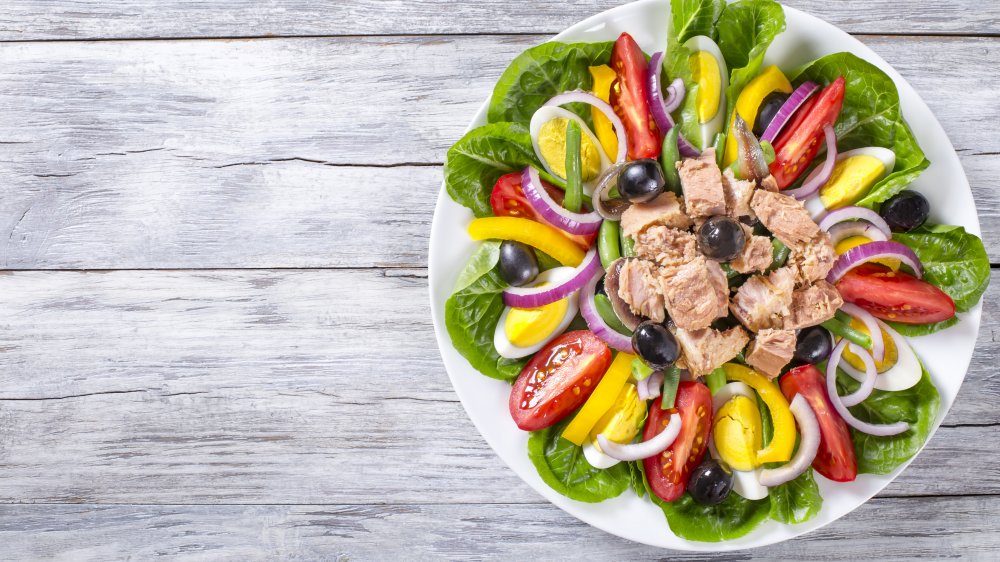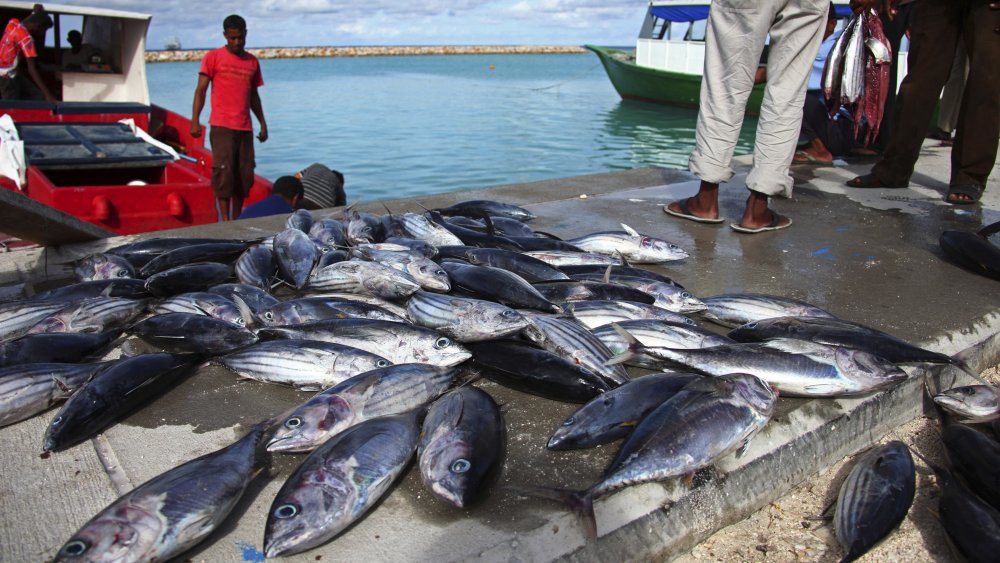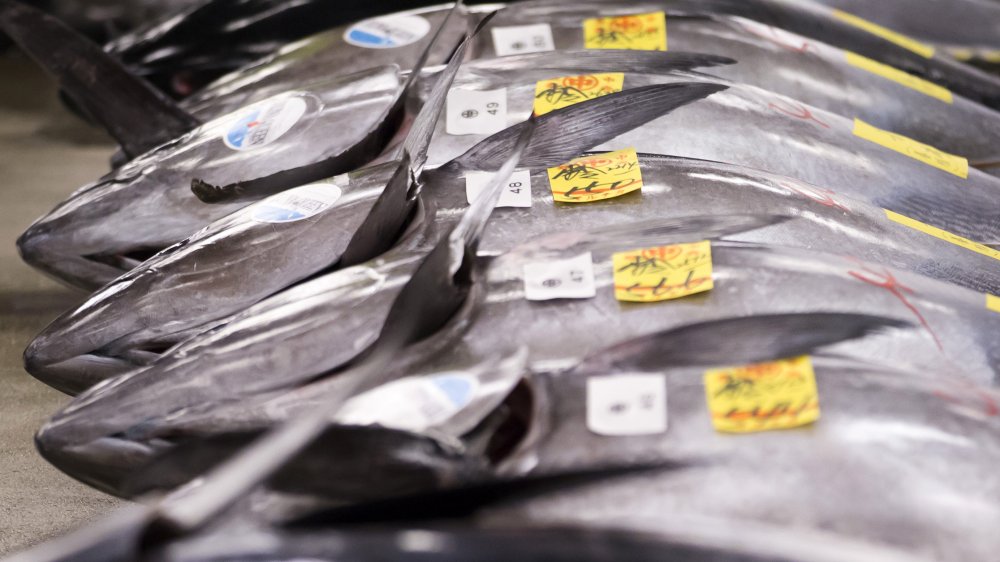What You Should Know Before Taking Another Bite Of Canned Tuna
Across the United States of America, canned tuna is a popular staple due to its affordability, high nutritional value, and lasting shelf life. Canned tuna makes for a great ingredient in meals like pasta and casserole, the perfect filling for a sandwich, or even a quick snack straight out of the tin. Of course, it's also the staple ingredient of a great tuna salad.
A trip to the grocery store will reveal that when it comes to this canned fish, there are numerous companies and varieties to choose from, including chunk tuna, solid tuna, albacore tuna, white tuna, and even bagged canned tuna (confusing, we know). If you plan on stocking up on some canned tuna on your next shopping trip, there are a few things you should know regarding where canned tuna comes from, what canned tuna's history is, and why it's a popular pantry item. Read on to find out more exciting information about this common lunch box staple.
Expensive canned tuna doesn't necessarily mean it's sustainably caught
Just like a lot of other foods, how expensive canned tuna is in the stores can be more or less a marketing ploy. Simply grabbing the can of tuna with the highest price tag could be a mistake for environmentally-conscious shoppers. There are other ways of telling if your canned tuna is sustainably caught, such as making sure to buy the correct variety of tuna and doing a little research on the company to ensure the tuna is not over-fished from endangered populations.
As it turns out, "pole and line" fishing and "trolling" are two sustainable methods for catching tuna because they're the closest methods to one fisherman with a rod catching tuna. And while these methods can yield expensive results, an expensive can of tuna does not automatically mean the tuna was caught with these more sustainable methods. That tuna may just have a fancy sticker and a great marketing campaign behind its higher price tag.
Canned tuna can have dangerously high mercury levels for certain populations
Tuna is notorious for its high mercury levels in all forms, and tuna from a can is no exception. While you probably don't have to worry too much about mercury content unless you are actively pregnant, the biomagnification of mercury in tuna may be worth thinking about. So what exactly does this big word "biomagnification" mean when it comes to tuna and your health?
Well, biomagnification occurs when tuna fish eat smaller animals with high levels of mercury, ultimately amplifying the amount of mercury in tuna. As a result, health experts recommend pregnant women eat no more than one can (or 12 ounces) of tuna a week to avoid too high a dose of mercury, which can cause abnormalities in a developing baby (via Healthline). This is essentially the same as the recommendation that pregnant women avoid sushi; avoiding raw fish means avoiding mercury. Ultimately the FDA's official position recommends pregnant and breastfeeding women are careful about their fish consumption, so being pregnant does not necessarily mean you have to swear off tuna salad forever.
There's a wide variety of canned tuna on grocery store shelves
Major tuna brands like Bumblebee and Chicken-of-the-Sea offer tons of different canned tuna options, and they're all different. Even if you have lived your whole life thinking you hate canned tuna, there may just be a product out there for you. For instance, some canned tuna is oil-packed, while some is packed in water or even vinegar. There is also chunk tuna, which means it contains various pieces of the fish mixed together. Essentially, this is the opposite of solid tuna that includes one complete filleted section of tuna that is whole, yet still flakey (via Spoon University).
Solid canned tuna is more expensive, but it's also generally regarded as more preferable. Canned tuna can even come in bags for on the go consumption, or pre-seasoned with hot sauce in the can. As we said, the chicken of the sea comes in quite a few canned varieties, and if you think canned tuna is not for you, it could just be that you haven't found the right canned variety yet.
People have been canning tuna for over 100 years
People have been canning tuna for a long time, maybe longer than you would expect! Tuna canning became popular in the United States of America in the early 1900s as companies were looking for a substitute for tinned sardines. Very quickly, canned tuna became one of the most popular preserved meat products for American consumers, with about 300 million pounds of the canned ocean fish imported into the United States each year. Most canned tuna comes from Asia, including Thailand, Indonesia, Vietnam, and the Philippines, but some canned tuna is also shipped to the United States from South American countries like Ecuador.
Tuna is not generally caught or packaged domestically, within the United States, because the fish is not super available in the nearby oceans. As it turns out, tuna's original success with American consumers came because as a fish, it does not actually have a particularly "fishy" taste, and its white color is more reminiscent of chicken.
Canned tuna has less omega-3 fatty acids than canned salmon or sardines
Fish is popular with American consumers in part because the food has a high volume of omega-3 fatty acids. Omega-3 fatty acids are beneficial for many reasons. Omega-3 fatty acids have been shown to improve eye and brain health, reduce the risk of heart disease, fight inflammation, and may even prevent against mental health issues like depression, anxiety, and ADHD.
That said, if you're looking to take in the highest concentration of omega-3 fatty acids, you may be better off sticking with another fish like sardines or salmon, or better yet simply taking the omega-3 fatty acids as daily fish oil supplements. Sardines and salmon have a higher concentration of omega-3 fatty acids than tuna, and thus may have more health benefits for consumers. Tuna still has some omega-3 fatty acids, however, and the fish has other health benefits beyond those fatty acids.
Overall, canned tuna is a really healthy food at a low price
Although canned tuna may not have as many omega 3 fatty acids as some of the other fish it shares the ocean with, tuna can be a great source of vitamin D, which might be hard to find if you live someplace that doesn't get much sunshine. Additionally, tuna has a low-fat concentration, low cholesterol, and low-sodium, though some people may assume otherwise because of the saltiness of the ocean.
For its nutritional value, tuna is also relatively inexpensive. One can of tuna is generally less than two bucks and you might even be able to stretch a single can for two meals. And unlike canned beef or pork products, canned tuna is going to offer a higher nutrient-to-cost ratio. Plus, we're betting it'll taste a lot better than some of those other carcinogenic canned meats. Canned tuna certainly isn't gourmet, but if you're on a budget it's definitely not a bad idea to throw a few cans in your grocery cart.
There are vegan alternatives available, but they are way less tasty
Atlantic Natural Foods makes a "plant-based seafood alternative" to canned tuna called TUNO. TUNO comes in a can, just like tuna, but is made of plant protein. While many plant-based alternatives to meat can be delicious and health-conscious choices, TUNO is probably not the greatest alternative. It's artificially fishy tasting and has a bizarre texture that is confusing, and a little off-putting.
There is also a trend of using watermelon as a tuna alternative because its pink color and juicy texture can match that of fresh, raw tuna. While it is creative, the watermelon tuna trend probably is not the best alternative for real canned tuna. Sure it may attempt to mimic raw tuna with its texture, but your taste buds will quickly realize that you're eating fruit and not fish. Until a better alternative comes along, real deal tuna is going to be your best bet over a plant-based alternative. Those who cannot eat canned tuna may be better off skipping canned tuna or its lesser substitutes altogether. Then again, if you find that you enjoy a watermelon casserole sandwich, go for it.
Some brands of tuna are more sustainable than others
Although more expensive canned tuna is not necessarily sustainable, there are some brands of canned tuna that are more sustainable than others. Because overfishing can deplete the ocean's resources and lead to declining fish populations, it's important to prioritize eating sustainably-sourced fish to maintain our access to those fish in the longterm.
Brands like Starkist, Hill Country Fare, and Walmart's Great Value are not good sources of sustainably caught tuna, quite the opposite. These brands are not ocean safe and do not protect sea life populations. In contrast, Whole Foods Market's 365 Canned Tuna, American Tuna, and Wild Planet provide some of the most sustainably sourced tuna available in U.S. grocery stores today. These brands are dedicated to safe and sustainable fishing practices and protecting the Earth's oceans so that generations in the future can enjoy the simple pleasure of canned tuna.
Canned tuna consumption has decreased in recent years
Despite canned tuna's rapid rise in popularity throughout the 1900s, in recent years, tuna consumption has declined, and consumers are opting against the canned fish. Starting in the mid-1980s, canned tuna sales began declining, and current consumption rates are as low as they once were in the 1970s.
Over 80 percent of American households once kept tuna as a staple in their cupboards, but fears about mercury poisoning and sustainability concerns have stifled the reign of the tuna fish, leaving consumers feeling disillusioned from the canned treat. Indeed, the midcentury days of canned tuna being marketed as a novel way of consuming fish using modern technology are long behind us, and tuna has become milquetoast, ubiquitous, and associated with boring school lunches for most American consumers. Fears about tunas toxicity and bad press about tuna fisheries being responsible for mass-killings of dolphins have also led to the downfall of the mighty tuna.
Actual tuna fish are big... really big
Tuna aren't just big, they're downright massive! The biggest bluefin tuna ever caught was caught in October of 1997 by Captain Eric Samson. The tuna was a whopping 1,496 pounds — and that's even after lying on a boat and losing water weight for ten hours. Still, that truly gigantic tuna fish took Captain Eric Samson only 45 minutes to reel into his boat. The tuna was pretty much twice as long as Eric Samson's height, and while this monster tuna dwarfs some of its smaller contemporaries, bluefin tuna are a very big fish with almost robotic features.
An adult bluefin tuna will grow up to 500 pounds, which means one tuna can produce a lot of cans of tuna, like a whole supermarket shelf's worth! Not only are bluefin tuna monstrously large, but they can command a fortune when they go to market. For example, in 2019, a single bluefin tuna sold for $3.1 million.
There's nothing fresh about canned tuna
This one should probably be a given, but, surprisingly, it is not. There is nothing fresh about canned tuna, as much as American consumers might want to think there is. Canning is, of course, a preservation method. Canning is a strategy for giving fish a long lasting shelf life, which is useful for keeping protein around as a pantry staple either for school lunches, when you are on your last meal in between grocery trips, or during, say, a nationwide coronavirus pandemic induced lockdown. No matter the occasion, canned tuna can be a great treat!
That said, tuna are caught long in advance of when they make it into your pantry in the form of a canned good, so if you are looking for a fresh fish, you'll be better off sticking with sashimi and poke, rather than a long-preserved can of solid white albacore packed in water.
Canned tuna is kosher
Those familiar with laws of kosher foods in the Jewish religion will know that Jewish people who keep kosher do not eat shellfish, as it does not fall within the laws of permissible foods according to kashrut, the set of laws that make foods okay to eat for certain observant Jewish people. Tuna, however, is not qualified as shellfish according to those rules, for a pretty simple reason: it does not have a shell. Perhaps, for this reason, tuna is actually a very popular food among Ashkenazi Jewish populations, and tuna salad is a well-known staple in most Jewish delis.
Much like smoked salmon, the preserved fish is a popular menu item in Jewish delis alongside similar fish dishes like smoked whitefish salad and smoked mackerel. Each deli, of course, may have its own particular extra ingredients that it adds to its tuna salad beyond mayo, such as olives, relish, celery, or even raisins, giving the tuna salad a unique and sweet crunch.
